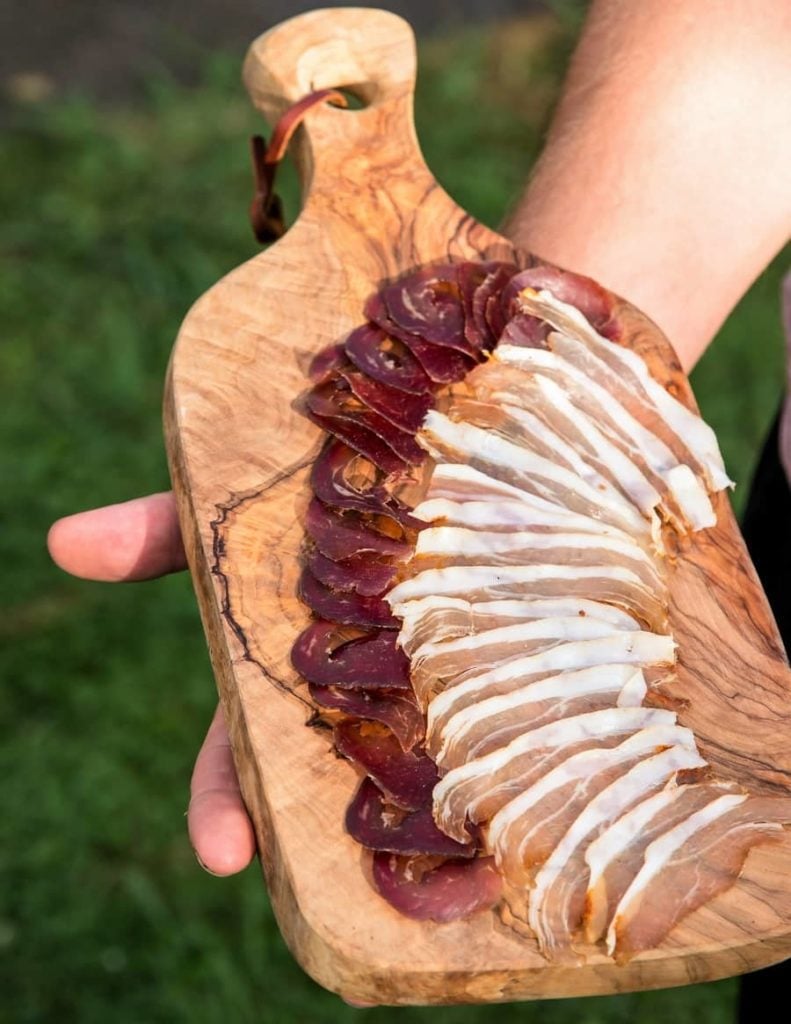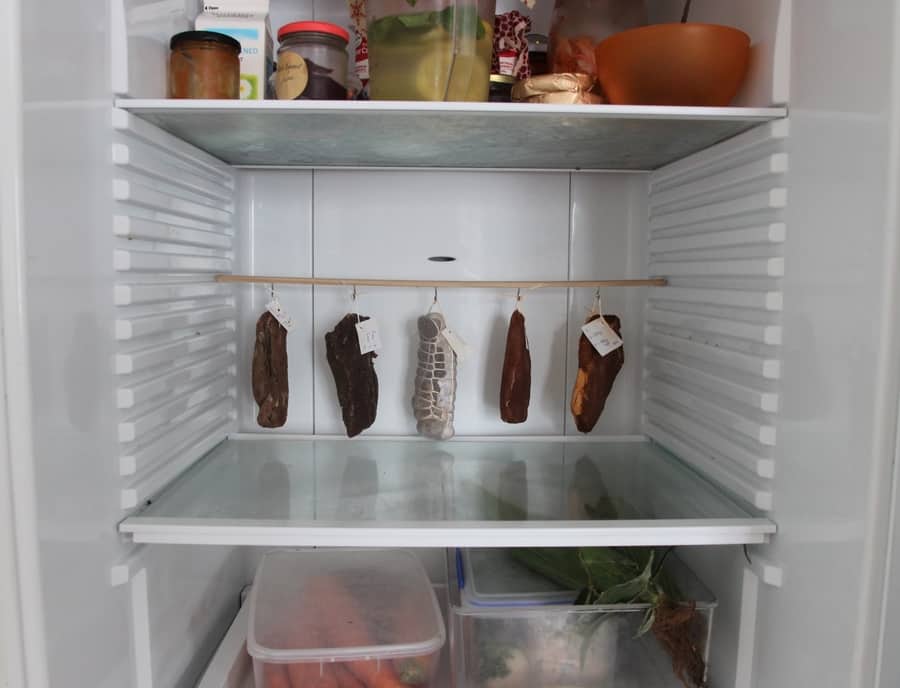Over the first 10 years, I was curing meat and made many mistakes. This had a lot to do with the lack of information, and I just hadn’t read the textbooks that are available nowadays. The internet was quite young in the early 2000s!
Key Summary:
- Over Salting the Meat During Curing
- Not Being in a Cure for Long Enough
- Not Using Quality Fresh Meat
- Hygiene and Not Keeping the Meat at Fridge Temperature Before Curing
- Not Having Optimal Conditions for Drying after Curing
- For Dry-Cured Salami, Not Creating An Effective Bind During Mixing
- Not Paying Attention to the Meat as it Loses Weight/Moisture
- Getting the Correct Airflow Around the Meat When Hung
- Not Trusting Your Senses
- Not Following Well Proven Methods and Processes
Over the second 10 years, I practiced and learned meat curing at home and worldwide.
It’s been more about refining the techniques and learning from all the outcomes and mistakes.
The central aspect of meat curing I use this for is to create dry-cured charcuterie meats such as whole-muscle pancetta or prosciutto.
This is a process of salting the meat, usually drying meat in favorable conditions.
Common Mistakes to Avoid When Curing Meat
Now, to go over each in detail.
Over Salting the Meat During Curing

This mistake can be avoided using methods such as equilibrium curing instead of saturation or salt box methods (article on this subject).
Traditionally, for hundreds and thousands of years, salt was used to cover the meat and left for a certain amount of time – this is the definition of the salt box method or saturation method.
This can not create consistent outcomes because of the difference in structure from one animal to another and other factors.
Saturated meat fully with salt is traditionally also how salt pork, salt beef or salt fish is created.
Not Being in a Cure for Long Enough
With the saturation salt curing methods, the meat is covered with salt and left for a certain amount of time, which is often also dependent on the weight of the meat.
A chunk of meat or whole muscle that is 5 to 7 inches thick can be challenging to salt. The salt has to penetrate to the meat’s core, which can take several weeks.
The whole project could be a waste if the salt has not penetrated the meat’s core.
Some factors, such as the amount of fat to meat ratio, can also vary the time it takes to cure meat. Animal fat has less water content the meat muscle, so the salt travels slower through it.
Decent pieces of pork belly have 30-50% fat.
Not Using Quality Fresh Meat
I’ve made this mistake by buying cheap pork at the supermarket ‘on special’ and using it to make dry-cured salami. The outcomes were not significant.
If you look at the culture around meat curing in Italy, the quality and freshness of the meat are always key factors.
Hygiene and Not Keeping the Meat at Fridge Temperature Before Curing
Sometimes, the process of meat curing can take quite a bit of time, especially the trimming or grinding of the meat – depending on what you are making.
You need to be in a cold environment to avoid the extensive growth of bacteria.
When I visited salami factories, I saw that they grind the meat, casing, and spices in a room kept at a refrigerated temperature.
Not Having Optimal Conditions for Drying after Curing

Dry-cured meats can be used in environments outside the ideal range of 50 to 60°F 10 to 15°C.
This humidity is generally for things that take more than a month or two and need at least 70% humidity but less than 85%.
I’ve heard from many people that they used temperature variations and even lower humidity.
I’ve written an article on how to make dry cured meats (small pieces) in a regular kitchen fridge as well.
What you risk is the drying happening too fast on the outside before the center is allowed to dry, sometimes known as case hardening. If this happens excessively, it can spoil the whole project.
For Dry-Cured Salami, Not Creating An Effective Bind During Mixing
One key aspect of making dry-cured salami is a level of bind or mix, where you extract some of the myosin out of the meat, which gives it a tacky feel.
These are not emulsified projects, such as hot dogs or mortadella, where you get a more uniform texture.
Depending on the meat and the ingredients – it’s under-mixing which has been a mistake that I’ve learned over the years.
Not Paying Attention to the Meat as it Loses Weight/Moisture
A friend of mine who I’ve taught how to make charcuterie dry cured meats (link to charcuterie/dry cured meats category list on this site) is a medical professional with a very busy life.
Sometimes, he might not check the cured meats drying for three or four days or a week.
I really think you need to check on drying meat every one to two days. Another option would be a backup contingency alarm probe for the temperature and humidity.
This is especially important when someone is building their own DIY converted fridge at the start of their charcuterie career at home.
You need to keep an eye on the drying process.
Getting the Correct Airflow Around the Meat When Hung
Drying meat does not take a year, but it does require some time.
It’s something like 5 meters/second; it’s tough to calculate this fan! I read that in a meat sausage curing commercial textbook.
Also, that might be a mistake, as there is not enough air exchange input and output from the drying fridge.
You do need air exchange to some degree. So, if you are converting a fridge, it may already have some cycle-through air exchange system.
Back in the day, a lot of cured meat was dried in caves in Italy, and they still do in Umbria.
Not Trusting Your Senses
Probably one of the most common questions is – what people are asking is whether their meat-curing projects are going all right or whether mistakes have been made.
My response is to have a really good smell. Our noses have developed over time to detect things that are probably not good or pleasant for our bodies.
Smelling is the key.
Of course, it is also very important to check how it’s drying and whether anything is growing on the casing or on the meat.
Trusting these two senses before using your taste is probably one of the most important things I’ve learned over the past 25 years to avoid making mistakes.
Not Following Well Proven Methods and Processes
Finally, I receive many comments and emails from people who send me a recipe that’s been handed down to them on a scribbled piece of paper.
As you can imagine, I have no idea how safe these methods are.
This is another reason why I’m cautious about recipes I post on cured meat.
I want to provide methods to avoid mistakes and have consistent, safe, and delicious outcomes!

Tom Mueller
For decades, immersed in studying, working, learning, and teaching the craft of meat curing, sharing the passion and showcasing the world of charcuterie and smoked meat. Read More
